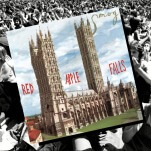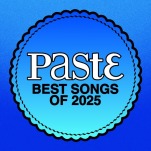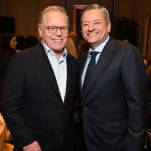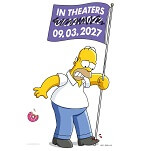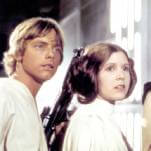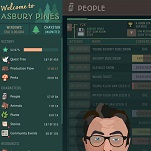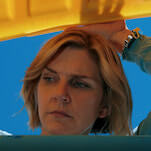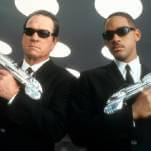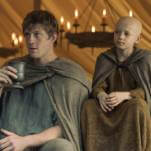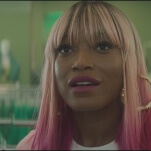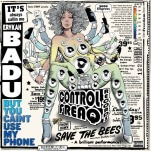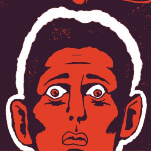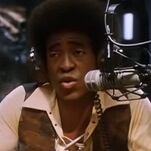Twenty years ago the German research group Fraunhofer IIS conducted an internal poll to settle on the three-character suffix that would become the standard file name extension for digital audio coding format that engineers there had developed. A few months later Fraunhofer released WinPlay3, the first software available to consumers that could play back, in real time, this new type of file based on the MPEG Audio Layer III codec, which the engineers there had unanimously decided would have the extension .mp3.
When Fraunhofer IIS rolled out the MP3, mainstream America was just starting to hear about the internet. Netscape Navigator was less than a year old, and the World Wide Web was only just starting to eclipse Usenet as the hub of online life. Major labels still released music on cassette. In-dash CD players were still considered a luxury feature.
Now we’re nearing the end of the MP3 era, as fatter bandwidth has made moving around big, lossless audio files like FLACs easier and cheaper, and increasingly robust streaming services have started making the entire concept of maintaining a personal music collection of files on a hard drive seem positively archaic, and the world’s a much different place, especially where music and technology intersect. A lot of people will be happy to see the MP3 go. (Some, like Neil Young and Bono, are even actively helping it along.) They allege that the MP3 has had a corrosive effect on music: It killed the record industry. It killed the album. It made music just sound worse overall, thanks to its loss-prone algorithm. They see a world of listeners bingeing indiscriminately on junk-food music chosen for them by software, content in a digital haze of sub-optimal audio fidelity.
The format doesn’t deserve its bad rap, though. Or at least not all of it.
It’s true that the MP3 pretty much cratered the record industry, or at least the one we knew at the turn of the millennium. A good portion of the blame should go to the record industry itself, which had plenty of advance warning that MP3s were going to shake things up but chose to double down on a business plan that revolved around $20 CD list prices rather than figure out how to monetize digital. (There was a four-year gap between the launch of Napster and the launch of the iTunes Music Store, music’s first major digital retail solution.) And while there are a lot of innocent musicians among the economic casualties from the transition away from the physical-media model, it’s hardly stopped people from playing and recording music. In fact, even as the monetary valuation of recorded music has plummeted, we’ve seen a surge in the amount of music being released as the cost of recording and releasing it has also dropped toward zero.
And the MP3 hasn’t killed the album, although it’s knocked it down a few rungs, which isn’t a bad thing. The album is an inexact and arbitrary standard to judge musicians by, and the ability to buy and listen to music a la carte simply exposed a fact that the LP era had wallpapered over: that most musicians aren’t made for making albums, and most people aren’t interested in listening to them. Great albums are still being released at about the same rate as they ever have been (consider the mass swooning over recent long-players by Kendrick Lamar, Donnie Trumpet & The Social Experiment, and Jamie xx, for instance), and the resurgence of the single has not only innovated the way musicians sell their works, but how they approach them creatively. Kanye has revived The Beatles’ formula of alternating statement albums with stand-alone singles that allow him to pursue ideas that don’t fit his longer statements (like acoustic pop excursions with one of The Beatles). Drake’s been using his SoundCloud page to beta test new material and share what are essentially fan remixes of other artists’ songs, not unlike the kind of stuff a lot of non-famous users post there.
Even the MP3’s most fundamental flaw, its loss-prone compression algorithm, has had consequences that have pushed music in unexpected ways. It’s no coincidence that the “loudness wars” in mixing and mastering that peaked in the mid-’00s as engineers struggled to wring every last bit of sound out of the newly dominant format, was followed by pop music, across all genres, embracing a more minimalist aesthetic that feels custom-made for digital listening (especially when paired with bass-heavy headphones).
The greatest thing that the MP3 has done for music is to break it free from the constraints of physical media, and in the process freeing it in other ways whose effects are only now starting to become apparent. It might be the single most important innovation in recorded music since recorded music was invented.
Thanks to the MP3, we live in a musically post-scarcity world, and there’s an entire generation coming of age for whom the idea of a rare recording is as unbelievable as the idea that at one point in time you could only hear music when and where it was being performed. First Napster, then file lockers, then YouTube and streaming platforms (whose business model would never have worked if rights holders weren’t desperate to offer the market a viable alternative to piracy) have put tens of millions of songs at the fingertips of anyone with an internet connection. Even if the average user only listens to current pop music, the pop paradigm itself has been completely upended as artists have begun exploring the internet’s infinite record collection.
One of the most significant side effects of loosing music from physical media is the damage it’s inflicted on the rigid genre orthodoxies that became entrenched at all levels of pop music during the rock era. Digital music gave artists a way around the gatekeepers who put themselves in charge of safeguarding the supposed authenticity of their scenes, and artists have responded by experimenting en masse with blending genres to the point that the distinctions between them have started to disappear completely. Ten years ago mashups of indie rock and hip-hop were a novelty; now hip-hop production techniques have become a standard part of the indie toolkit, and rappers have borrowed just as much in return from indie rock (and both have similar relationships with dance music).
This genre-smashing revolution is only getting more pronounced as it becomes more and more the status quo. If Lorde singing dreamy pop over minimalist hip-hop beats and Kanye rapping over krautrock were emblematic of its early days, its future might look more like London O’Connor, whose recent debut LP, O∆, doesn’t just bring together the influences of Daniel Johnston and Odd Future but exists in some sort of quantum superposition between the two.
The MP3s facilitated a sea change throughout music on all levels that’s bigger than anything since maybe the countercultural upheavals of the ’60s, but it probably won’t ever get much credit. Intangible and infinitely replicable, it will never inspire the kind of sentiment that vinyl, cassettes, and CDs have over the years. The more ubiquitous digital music’s become, the less the format itself has mattered, and that be one of its greatest accomplishments: fading into the background and letting the music speak for itself.

